How to Create Diagrams With ChatGPT for Your Projects
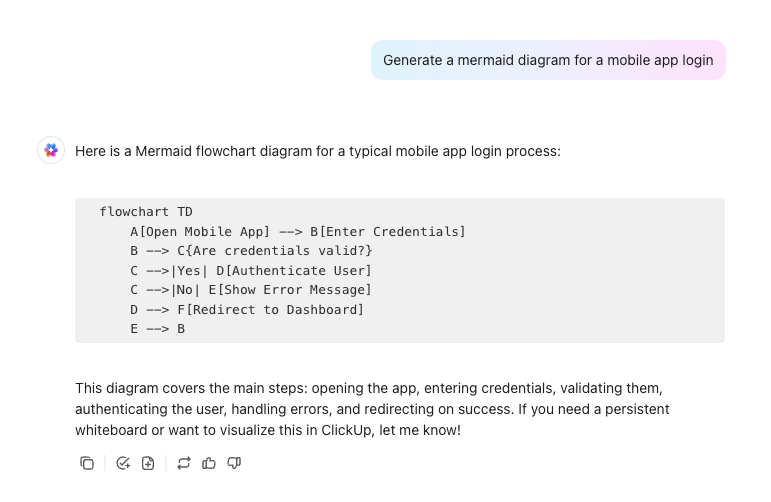
Sorry, there were no results found for “”
Sorry, there were no results found for “”
Sorry, there were no results found for “”

If you’re a project manager, you must be familiar with diagraming tools like Lucidchart, Miro, and Draw.io.
They’re great for precision, custom styling, and team collaboration. However, they can be time-consuming. Chances are, you’re spending more time aligning boxes than thinking through the logic.
With ChatGPT, it’s the opposite. Describe what you need in plain English. Say “Create a swimlane diagram for our QA process,” and you’ll get a draft in seconds. When you’re looking for ideation or simplifying concepts on the fly, it works great.
In this article, we explain how to create diagrams with ChatGPT using simple, easy steps that anyone can follow.
The first one is a UML diagram template. Software engineers and developers use it to understand processes, organize data, and decipher relationship lines.
ClickUp’s UML Activity Template helps your teams map complex workflows. From user stories to project management, they provide a way to track and document all your processes.
With this whiteboard template, you can:
ChatGPT has myriad uses, including content creation, brainstorming, visual planning, and structuring complex ideas. But it can’t directly generate diagrams like a design tool would.
With the right prompt, it can output a visual layout in text, Mermaid.js, or even generate an image, making it a powerful assistant for rapid diagram creation. Here’s how to make the most of it.
When you define the objective first, you’re giving ChatGPT the ‘what’ and ‘why’ behind the diagram. That helps it choose the right structure and logical flow, saving you the effort of having to backtrack or explain corrections later.
For example:
The right diagram depends on your goal.
Project managers often map workflows, clarify responsibilities, or prep stakeholder updates. Engineers use diagrams to explain system architecture, API flows, or dev handoffs.
For example, flowcharts capture linear processes, swimlanes show team responsibilities, and sequence diagrams map real-time interactions between systems.
Let’s look at the different diagram examples you could explore for your projects:
| Diagram type | Use case | Best for |
| Flowchart | Step-by-step logic or workflows | SOPs, onboarding, dev handoffs, user flows |
| Swimlane Diagram | Parallel workflows across roles | Product-dev-QA coordination, cross-functional planning |
| Gantt Chart | Timeline-based project planning | Tracking deadlines, dependencies, and milestones |
| Mind Map | Ideation and content planning | Brainstorms, tech planning, sprint backlog refinement |
| Org Chart | Team structure and hierarchy | Onboarding docs, stakeholder visibility |
| RACI Matrix | Role clarity in projects | Clarity across PM, engineering, QA, design |
| RAID Log | Risk and dependency tracking | Surfacing blockers in product-engineering cycles |
| Sequence Diagram | Ordered interactions between components | API flows, login sequences, service-to-service communication |
| Workflow Diagram | End-to-end business or product processes | Mapping internal processes, automation pipelines, approvals |
| Architecture Diagram | System or application architecture | Engineers defining services, databases, integrations |
When your teams are cross-functional, visuals make communication faster and reduce ambiguity.
Example: PM and engineer collaborating with ChatGPT
Let’s say a project manager wants to map the user journey for a new feature. They prompt ChatGPT:
“Create a flowchart for our new onboarding experience: Signup → Email Verification → Profile Setup → Dashboard Access.”
ChatGPT outputs a logical flowchart layout.
Now the engineer steps in to extend it:
“Add backend actions to each step. For example, Signup → Trigger user creation API → Store in database.”
ChatGPT updates the diagram to include both the user-facing journey and the backend operations. It turns a basic idea into a dev-ready blueprint. All this without design tools or Slack ping-pongs.
The quality of your diagram entirely depends on how clean and clear your prompt is, as well as how you detail each step.
Let’s understand this with a quick example.
Suppose you are a project manager working on an online payment app. Now, if you prompt the tool for a sequence diagram of an online payment app without proper context or details, the tool provides a text-based output rather than a diagram.
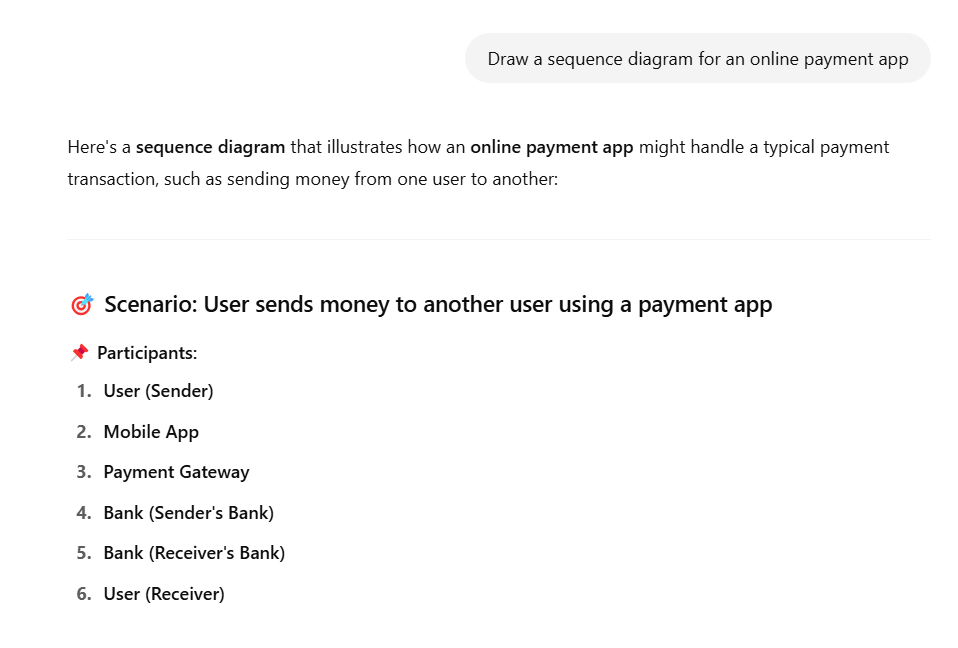
Now, let’s try again with a prompt that includes the steps in detail, along with the elements and their relationships.
ChatGPT will respond with either:
In the case below, we’ve asked ChatGPT to respond with Mermaid.js code.
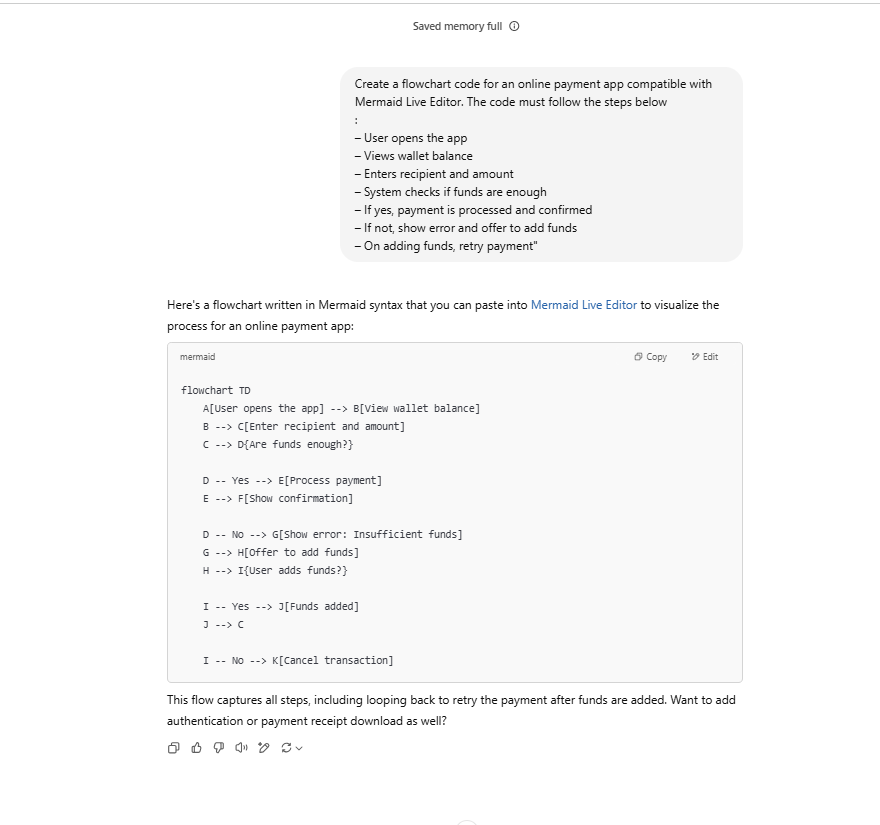
Notice the improvement? The clearer your input, the better your output.
You can even go beyond diagrams. Use ChatGPT to generate actionable tasks based on each element of your flow or user journey.
📮 ClickUp Insight: 37% of our respondents use AI for content creation, including writing, editing, and emails.
However, this process usually involves switching between different tools, such as a content generation tool and your workspace. With ClickUp, you get AI-powered writing assistance across the workspace, including emails, comments, chats, Docs, and more—all while maintaining context from your entire workspace.
Once you generate the code, you can copy and paste it into third-party apps like draw.io or Mermaid Live Editor to generate your diagram.
Your final diagram output will look something like this:
Most tools allow you to download the diagrams without any hassle. In the case of Mermaid Live Editor, you can share your diagram, the code, and more as shown below:
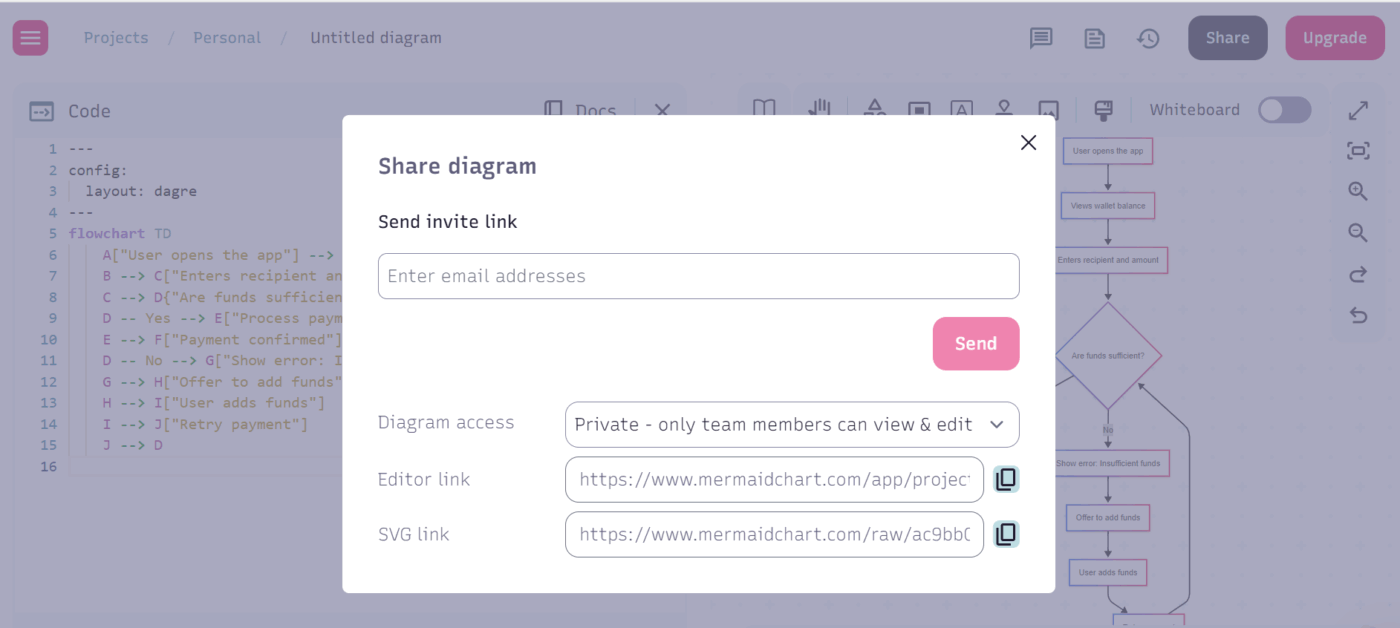
There is a good chance that the generated code may require some error correction, or you may want to add or remove certain elements. Whatever the case, most third-party apps allow you to alter code, fix errors, and add elements and images.
Considering the same example, let’s assume you want to stack the steps vertically; in that case, ChatGPT’s output would look like this:
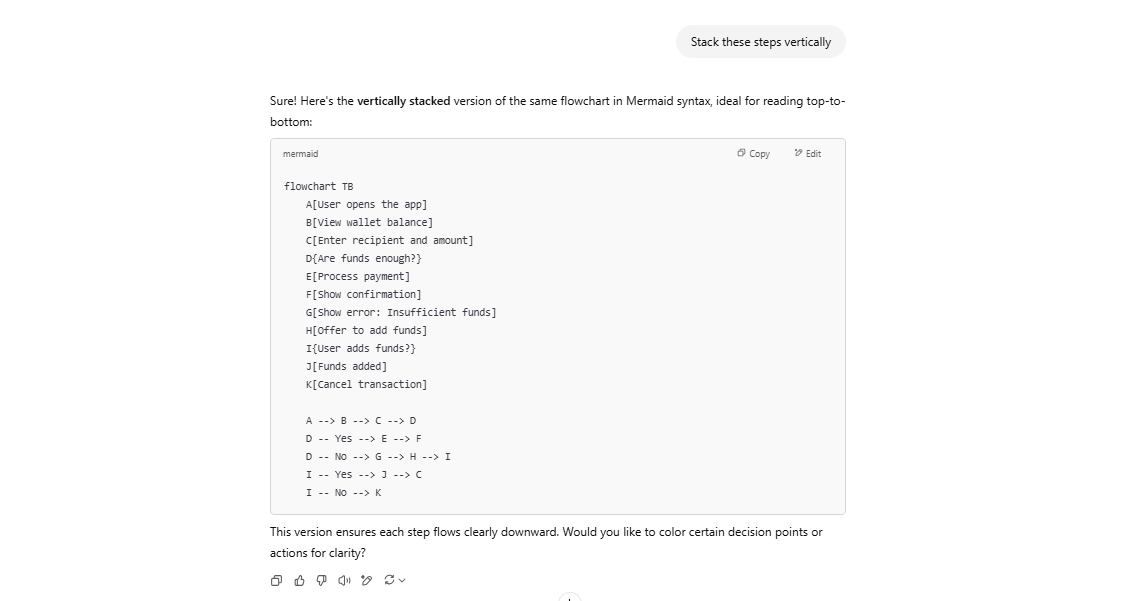
When you copy and paste this code in Mermaid Live Editor, your diagram would look like this:
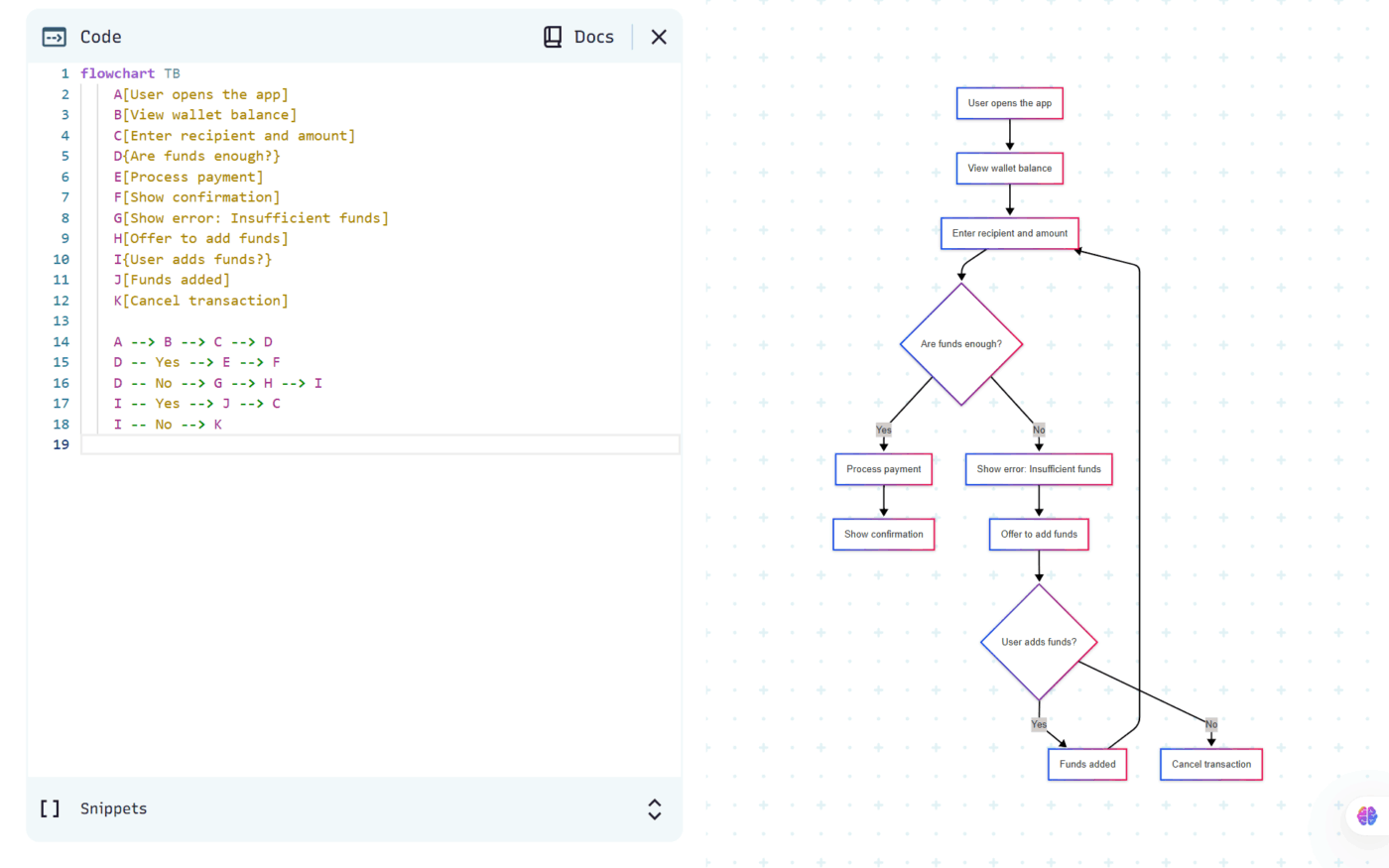
You can also add details. For instance, you can modify your Mermaid code to highlight failure paths in red. Here is how the output would look:
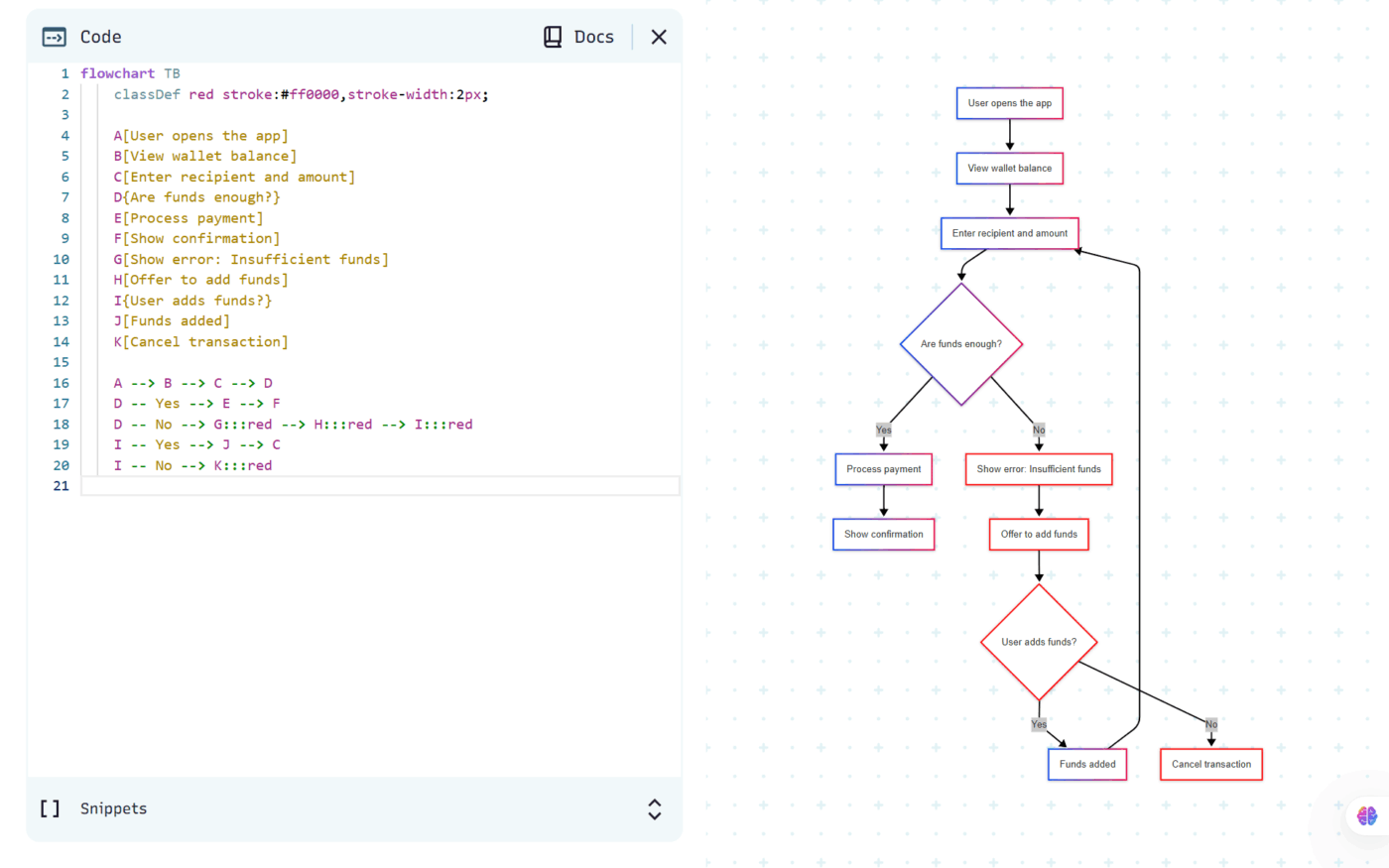
You can continue to tweak the code until you achieve the desired output.
💟 Bonus: Brain MAX is your AI-powered desktop companion that brings true context to diagram workflows. With deep integration across your projects, documents, and team communications, Brain MAX understands the details and relationships within your work.
Just describe your process or workflow using voice or text, and Brain MAX instantly generates clear, accurate diagrams tailored to your context—whether it’s a project timeline, decision tree, or process map. It can pull in relevant tasks, deadlines, and dependencies from your workspace, ensuring every diagram reflects your real-world workflow. Plus, you can update, refine, and share diagrams effortlessly, making collaboration and process optimization seamless and intuitive.
What’s next after you have the diagram from ChatGPT? Here are some ways to use it in your workflows:
Mermaid.js code
If ChatGPT outputs Mermaid syntax, you can copy it directly into:
Generated images
Download as-is for use in:
👀 Did You Know? You can guide the style when generating images in ChatGPT. Want a diagram in sketch form? A photo-realistic mockup? An abstract illustration? Mention it in your prompt—it adjusts accordingly.
You can ask ChatGPT to reformat the diagram if you want to switch styles:
💡 Pro Tip: The fix to most syntax errors is simple. Just prompt or describe the problem to ChatGPT.
For instance, ‘The code won’t render, there’s an error near line 3. Fix it and any other errors you find,” and ChatGPT will most likely correct the error (and any other issues it finds).
Besides the benefits of diagramming using ChatGPT, there are some limitations and challenges attached.
❌ No direct image creation: Although ChatGPT generates diagram code, it cannot produce finished images on its own. You’ll always need to paste the code into external, third-party diagram makers. This extra step is time-consuming, especially when you need to generate diagrams in bulk
❌ Complex layouts need manual intervention: Simple diagrams and flows work perfectly. However, this doesn’t apply to diagrams that have multiple interconnected or complex elements, which require human intervention or fine-tuning
❌ Syntax errors: Occasionally, the generated code may contain minor issues that can prevent rendering. Some common issues include a missing comma, bracket, TD, or LR (Top-down, left-right) element, or incorrect arrow types. This can lead to back-and-forth to get the perfect diagram (which might again not be ideal for quick tasks)
❌ Struggle with advanced technical diagrams: It may lack depth and accuracy when it comes to advanced ChatGPT examples, such as technical and engineering diagrams or exact architectural plans that require precise measurements and specialized tools
❌ Static output only: Unlike dedicated diagramming tools, ChatGPT-generated diagrams may lack interactive features, such as clickable elements, pop-ups, or dynamic updates and changes
If you’re a project manager mapping out sprint plans or an educator breaking down complex ideas, ChatGPT can give you the first draft.
But when it’s time to turn those ideas into something you can actually present or collaborate on, you’ll need a visual tool.
That’s where ClickUp, the everything app for work, makes your life easier.
Let’s see how!
ClickUp Brain is ClickUp’s built-in AI assistant that works right inside your tasks, docs, and projects.
Instead of switching between ChatGPT and your workflow tools, you can bring the power of AI directly into where the work happens. From writing to reasoning to visual planning, it helps teams move faster, without jumping between apps.
Now let’s put this into context.
Your project management team can ask Brain to generate a workflow diagram draft, summarize meeting notes, or create a visual sprint roadmap—all within the task or doc they’re already using.
Here, we ask Brain to generate a 4-sprint roadmap for the launch of a payment app.
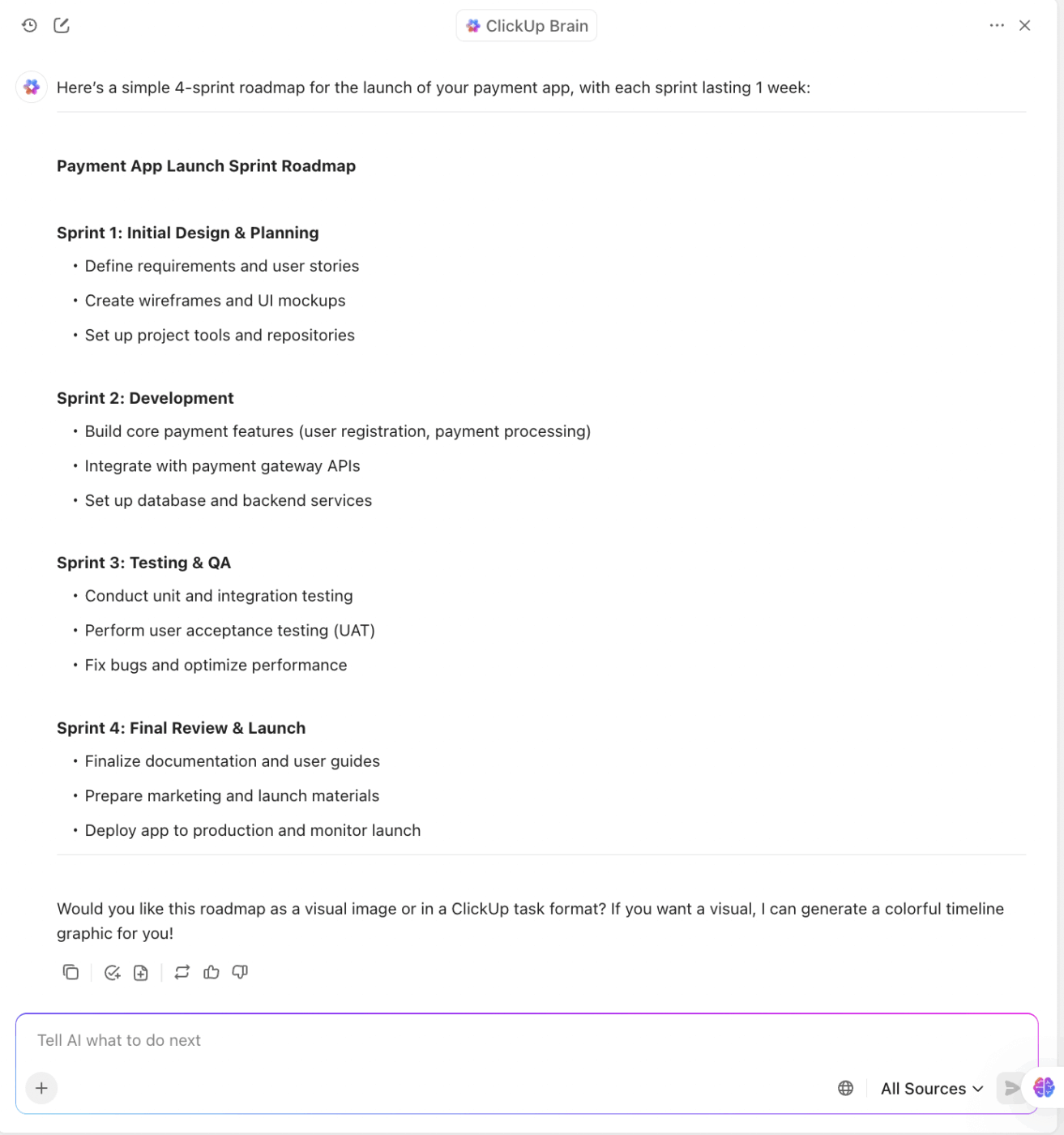
Meanwhile, your developers can use the same space to generate sequence diagrams, request code snippets, or document backend architecture, without leaving ClickUp.
Now, for the above sprint, you can even generate code snippets for each step. If you’re a project manager, the benefit of this feature is that you don’t need to depend on the tech team for every small change. You can make them yourself.
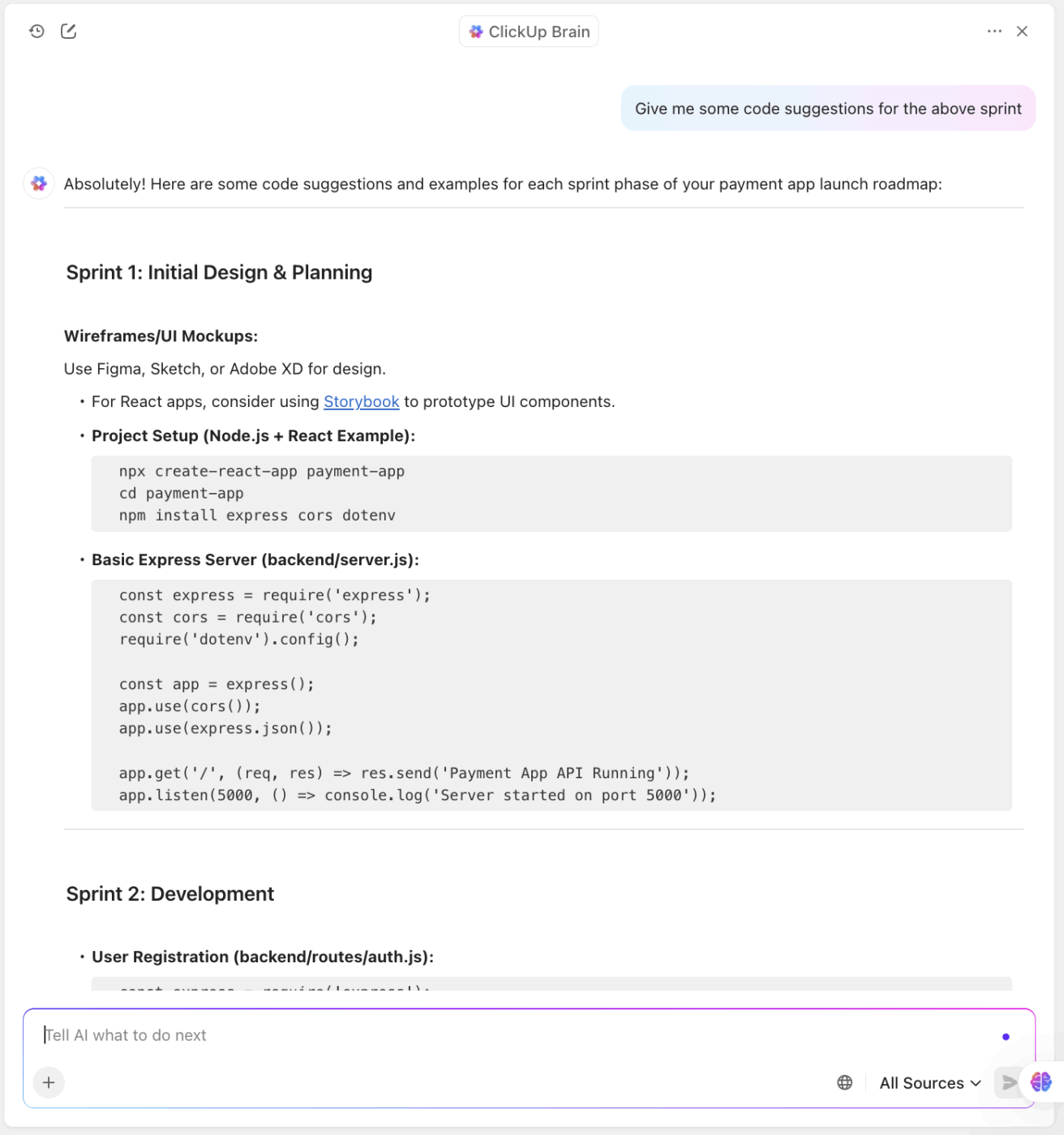
Since ClickUp Brain allows users to choose from multiple external AI models, including Claude, ChatGPT-4.0, and Gemini, you can use Brain to brainstorm, write, reason, and code, among many other things.
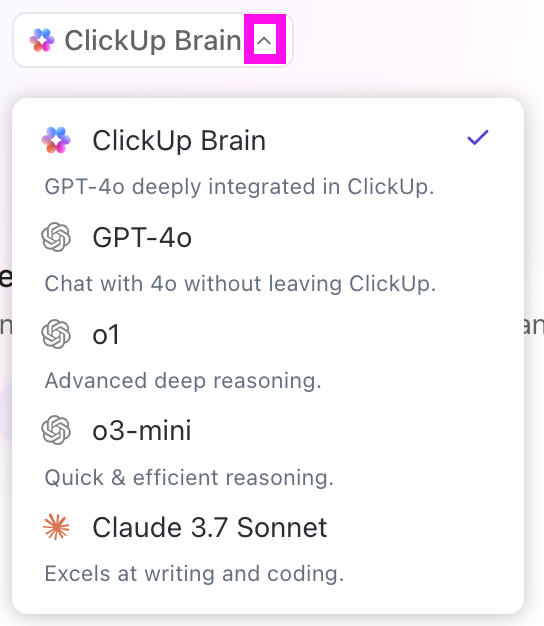
Adding to that, with AI image prompts, you can even generate images within ClickUp.
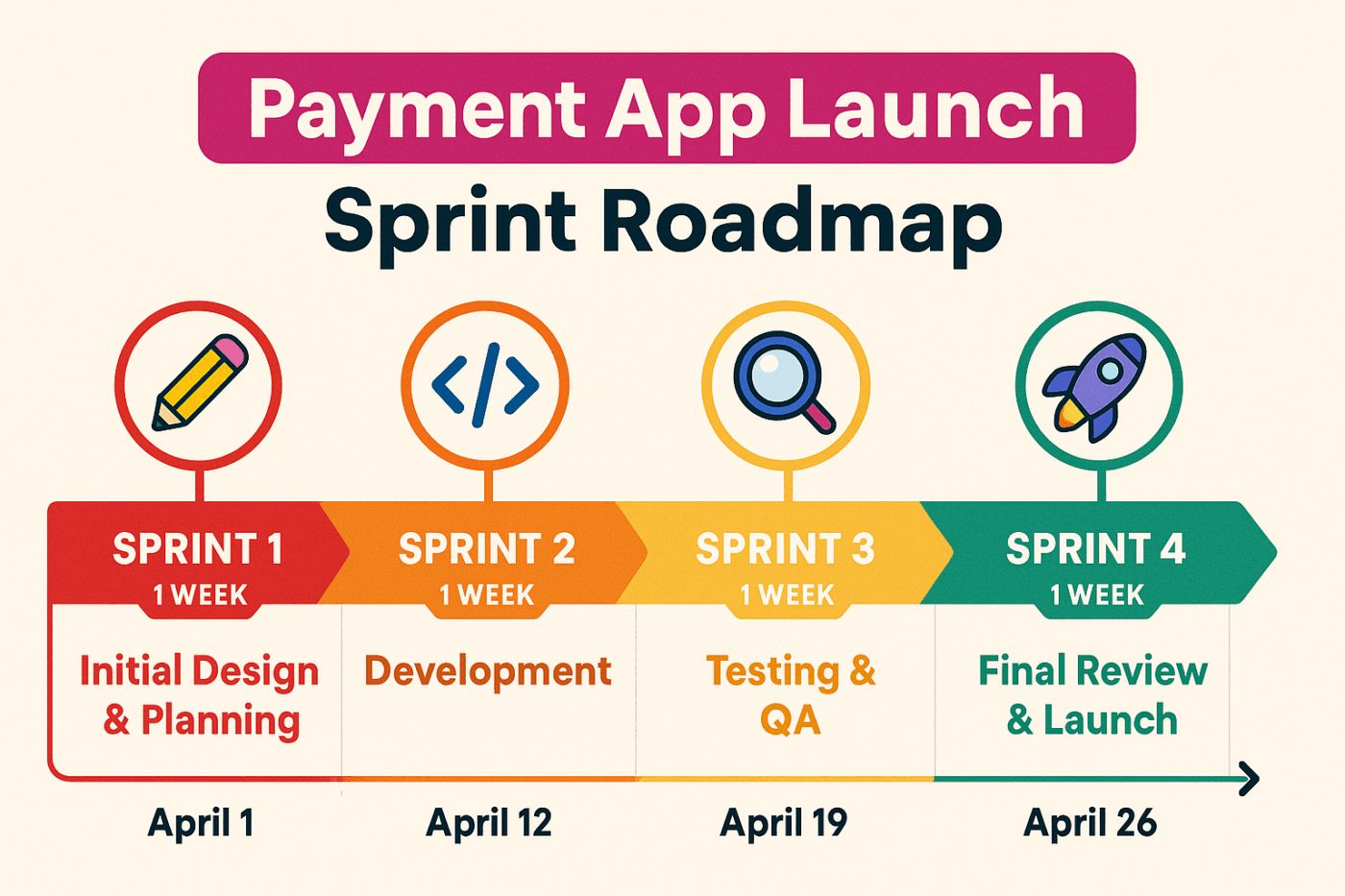
Whether you need technical assistance or creative brainstorming, ClickUp Brain allows you to do it all.
Once you’ve created diagrams with ChatGPT and ClickUp Brain, what if they could update or trigger automatically, based on actual work happening in your project?
That’s where ClickUp Agents come in.
These intelligent, customizable assistants can take action on your behalf. For example:
Regardless of your workflow diagram—whether managing dev sprints, cross-functional workflows, or stakeholder handoffs—ClickUp Agents turn manual diagramming into automated, context-aware actions.
You focus on the thinking. Let your workspace handle the updates.
You’ve completed the first step of drafting a diagram with Brain.
Now, when you want to collaborate or brainstorm ideas with your team, you need a virtual whiteboard.
ClickUp Whiteboards gives you a drag-and-drop visual space to map workflows, brainstorm solutions, or co-create architecture diagrams.
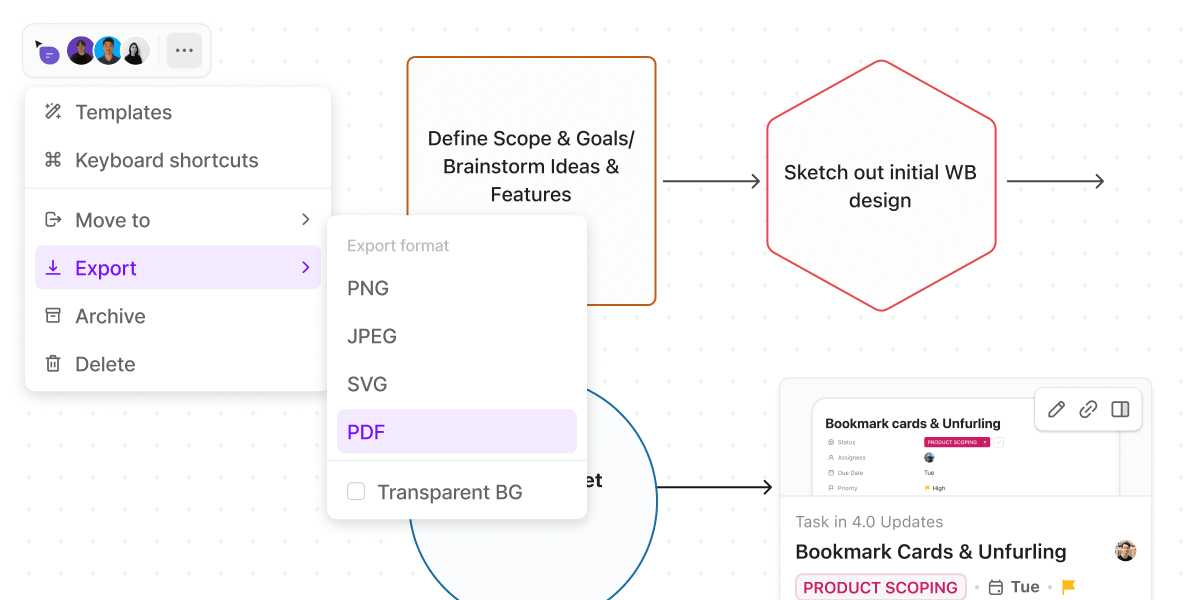
You can drop in tasks, link ideas, annotate directly, and turn sticky notes into action items without leaving the canvas.
Here’s how you can use Whiteboard:
Let’s see how ClickUp Whiteboards helps you take your ideas from concept to execution.
In just a few minutes, the product team sketches a workflow, adds sticky notes, and links every shape to real tasks, so you can watch an idea move from rough diagram to live project without ever leaving ClickUp.
What’s the edge over diagraming tools?
Whiteboards are directly connected to your tasks and projects in ClickUp, so everything stays actionable and in sync.
For more structured planning, ClickUp Mind Maps help you turn abstract ideas into clear, connected task hierarchies.
Say you’re a project manager building a product rpadmpa. Or a developer visualizing system architecture before translating components into development tasks. Or a knowledge worker wanting to organize research findings into connected themes.
ClickUp Mind Maps are your go-to tool for clarity.
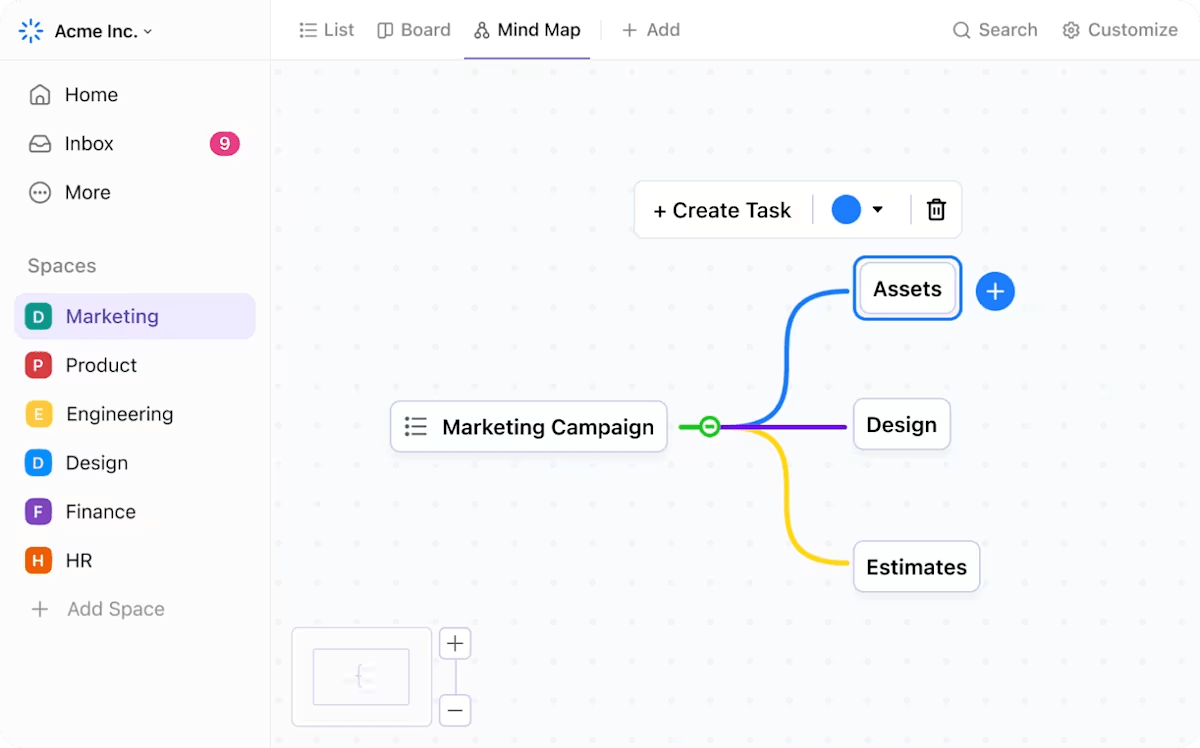
With Mind Maps, you can:
🧠 Fun Fact: Your brain naturally thinks in branches. A study shows the brain doesn’t think in lists—it connects ideas like a web. That’s why mind maps often feel more intuitive than bullet points.
Even with ChatGPT and AI-assisted planning, starting from a blank canvas can feel overwhelming. More so when you’re pressed for time or unsure how to structure your thoughts.
That’s where ClickUp’s pre-built templates come in.
They solve key pain points like:
Whether you’re diagramming workflows, mapping dependencies, or ideating features, ClickUp’s templates help you go from AI draft → collaborative diagram → actionable task list in minutes.
Here are some templates to help you get started.
The first one is ClickUp’s Pyramid Whiteboard Template, which helps you organize your ideas into pyramids for quick comprehension. You get the best of both worlds: the freedom to draw diagrams and diagrams with just the right structure to easily document and visualize your work.
This whiteboard template allows you to:
Lastly, ClickUp’s User Flow Mind Map Template allows you to create a visual map of how users will interact with your product or website. This template helps you identify areas of opportunity and potential gaps and gain insights into how people will interact with your product.
Here’s how you can use this template efficiently:
You now know how to create diagrams with ChatGPT. They’re fast, flexible, and intuitive.
But when you embed that into ClickUp, your diagrams do more than communicate—they activate.
From AI-generated roadmaps to automated updates and collaborative whiteboards, your entire team can work visually, quickly, and in sync.
Explore ClickUp Brain, Agents, Mind Maps, and Whiteboards to turn your next diagram into something truly dynamic.
Build with ClickUp. Collaborate without context-switching. Sign up for free.
© 2025 ClickUp